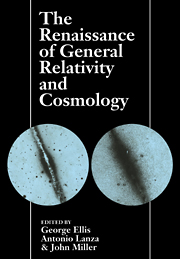 The Renaissance of General Relativity and Cosmology
The Renaissance of General Relativity and Cosmology Book contents
- Frontmatter
- Contents
- Author Addresses
- 1 Introduction
- 2 Exact and inexact solutions of the Einstein field equations
- 3 Inertial forces in general relativity
- 4 Relativistic radiation hydrodynamics: a covariant theory of flux-limiters
- 5 Relativistic gravitational collapse
- 6 The cosmic censorship hypothesis
- 7 The Kerr metric: a gateway to the roots of gravity?
- 8 Galactic astronomy since 1950
- 9 Galaxy distribution functions
- 10 Nonlinear galaxy clustering
- 11 Quasars: progress and prospects
- 12 Decaying neutrinos in astronomy and cosmology
- 13 Cosmological principles
- 14 Anisotropic and inhomogeneous cosmologies
- 15 Mach's principle and isotropic singularities
- 16 Implications of superconductivity in cosmic string theory
- 17 The formation and evaporation of primordial black holes
- 18 Evaporation of two dimensional black holes
- 19 Topology and topology change in general relativity
- 20 Decoherence of the cluttered quantum vacuum
- 21 Quantum non-locality and complex reality
- 22 The different levels of connections between science and objective reality
4 - Relativistic radiation hydrodynamics: a covariant theory of flux-limiters
Published online by Cambridge University Press: 15 December 2009
- Frontmatter
- Contents
- Author Addresses
- 1 Introduction
- 2 Exact and inexact solutions of the Einstein field equations
- 3 Inertial forces in general relativity
- 4 Relativistic radiation hydrodynamics: a covariant theory of flux-limiters
- 5 Relativistic gravitational collapse
- 6 The cosmic censorship hypothesis
- 7 The Kerr metric: a gateway to the roots of gravity?
- 8 Galactic astronomy since 1950
- 9 Galaxy distribution functions
- 10 Nonlinear galaxy clustering
- 11 Quasars: progress and prospects
- 12 Decaying neutrinos in astronomy and cosmology
- 13 Cosmological principles
- 14 Anisotropic and inhomogeneous cosmologies
- 15 Mach's principle and isotropic singularities
- 16 Implications of superconductivity in cosmic string theory
- 17 The formation and evaporation of primordial black holes
- 18 Evaporation of two dimensional black holes
- 19 Topology and topology change in general relativity
- 20 Decoherence of the cluttered quantum vacuum
- 21 Quantum non-locality and complex reality
- 22 The different levels of connections between science and objective reality
Summary
A fully covariant approach to transfer phenomena by using flux-limiters is presented. Explicit formulas for the radiation flux and radiation stress tensor are given for a wide class of physical situations.
INTRODUCTION
In several areas of cosmology and astrophysics the transfer of radiation through high-speed moving media plays a crucial role (accretion flow into black holes, X-ray bursts on a neutron star, supernova collapse, jets in radio sources, galaxy formation, phase transition in the early universe). If one wants to take into account all the effects associated with these transport processes, the full relativistic transport equation must be used.
Early discussion of radiative viscosity was performed by several authors in a non covariant formulation (Jeans 1925, Rosseland 1926, Vogt 1928, Milne 1929), but the appropriate transfer equation for the case of special relativity was given in a classical paper by Thomas (1930). A manifestly covariant form of the transfer equation was obtained by Hazelhurst and Sargent (1959), by using a geometrical formalism. Finally Lindquist (1966) performed the extension to the general relativistic situation and Mihalas (1983) analyzed in depth the order of magnitude of the various terms which appear in the transport equation.
From a mathematical point of view, the transport equation is an integro—differential equation and the task to solve it is in general very hard.
- Type
- Chapter
- Information
- The Renaissance of General Relativity and CosmologyA Survey to Celebrate the 65th Birthday of Dennis Sciama, pp. 59 - 72Publisher: Cambridge University PressPrint publication year: 1993


